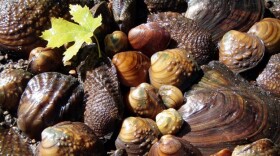
Gretchen Gerrish
Commentator - Field NotesGretchen Gerrish works for UW-Madison's Trout Lake Station through the Center for Limnology. She studies how evolutionary and ecological processes interact to allow natural systems to deal with change over time.
Most of her work focuses on zooplankton, microscopic invertebrates that provide the food-web link between fish and algae.
-
Many people are aware that trees can be dated by counting the layers of tree rings in a cross section. But, less folks know that fish, snails, mussels, and the teeth of many local mammal species build seasonal growth rings that are used to age individuals.
-
While they’re famous among anglers, few people realize that Canadian Nightcrawlers—Lumbricus terrestris—have a fascinating biological story all their own, one that stretches across continents and ecosystems.
-
‘Fish’ is one of those words, useful in the image it evokes but less reliable as a lineage, clearly defined.
-
Seasonal blooms are common and often monitored in warm and high nutrient lakes throughout southern Wisconsin, but are less commonly reported in lakes up north. This makes it challenging to track and manage across the 1,000s of regional lakes.
-
Open lakes, no snow, and sweatshirt weather was the scene this December in Vilas County. Much to the chagrin of ice anglers and cross country skiers, El Nino has taken hold and has had many implications for the local people, economy, and ecosystems.
-
By the end of last month, northern Wisconsin had already reached the ‘severe or ‘very severe’ annual winter index thresholds set by the Wisconsin DNR for the first time since 2013
-
In this month's installment of Field Notes, Trout Lake Station’s Gretchen Gerrish takes us to Florida with a lesson about marine field research.
-
If you walk barefoot in a lake or stream, your feet might slide on slippery stones. What makes them so slippery? In this month’s installment of Field Notes, Trout Lake Station’s Gretchen Gerrish takes us underwater to learn about life on rocks.
-
What it's like raising chickens through a Northwoods winter.
-
While many organisms thrive solely feeding on the leaves, roots and fruits of trees, very few are capable of efficiently incorporating wood into their diets.











